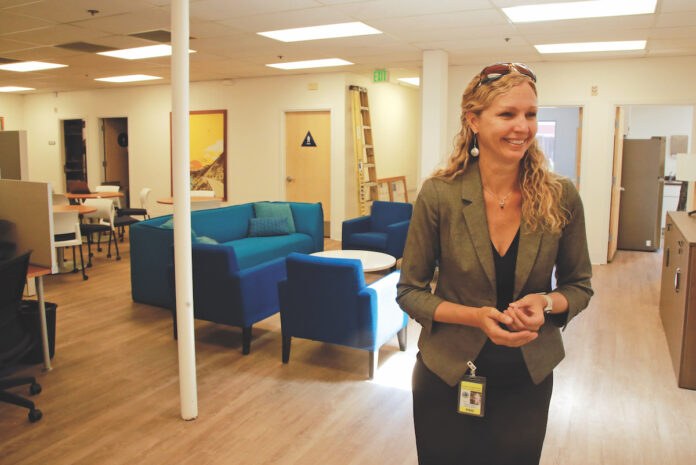
SANTA CRUZ—Santa Cruz County’s new Public Defender office began operations on July 1, and the department’s roughly 60 employees celebrated the occasion with a barbecue in the backyard of its May Avenue headquarters.
The new office includes an increased number of attorneys, in addition to a team dedicated to giving clients the extra help they need in a so-called holistic model of defense.
The county’s takeover of public defender services began in 2020, when the Board of Supervisors approved the plan. The contract for Biggam, Christensen and Minslof (BCM)—the law firm that filled that role for 45 years, expired on Friday.
Santa Cruz County was one of the last in the state to move to a county-run model. County officials touted the plan as a way to give public defenders access to county services such as the Health Services Agency, and the Human Services and Probation departments.
That relationship is a key difference in the new department, says Public Defender Heather Rogers, who heads up the office.
Under this new “holistic” model, clients can now receive services they might need—and which often lead to their legal troubles—such as mental health, drug treatment and housing services, in addition to legal defense.
Offices that practice this model also employ civil, family, and immigration lawyers.
This, Rogers says, will help the defendants stay out of trouble once their sentences have been completed.
“We want to make sure that folks get the resources they need to lift themselves up and out of the system, rather than the revolving door of recidivism that I’ve experienced as a PD for 20 years,” she said. “You see the same clients, and no matter what you do for them in their defense, if you don’t address what brought them to the system they’re just going to keep going back. It’s frustrating.”
This philosophy is increasingly being adopted by criminal defense attorneys as providers shift focus on addressing the root causes of the crimes, rather than punishing them after the fact.
This is an important distinction, since a vast majority of criminal defendants receive services from public defenders, according to a 2019 study in the Harvard Law Review.
While the study found that a holistic approach has neither a positive nor a negative outcome on recidivism, it has been shown to reduce the likelihood of jail or prison sentences by 16% and expected sentence length by 24%.
But those results are likely to evolve, since the holistic philosophy is still in its relative infancy, the study shows.
“I think that it’s a better model for the population that we serve, because by working together with other county and community partners, we can get this right, and we can make truly collaborative relationships,” Rogers said. “We’re trying to go upstream to prevent downstream consequences.”
Rogers, who turned 48 on Saturday, was admitted to the State Bar of California in 2003. She has spent the bulk of her career in criminal defense.
She began that year as a Judicial Law Clerk for the 9th Circuit Court of Appeals in San Diego, and then served for three years as an Assistant Federal Defender. She then hung out her shingle, running her eponymous practice in San Diego for nearly two years before joining the Monterey County Public Defender Office as Felony Trial Team Leader.
She served as Assistant Federal Defender in San Jose before joining BCM in April 2012. The Santa Cruz County Board of Supervisors confirmed her to lead the new office in Sept. 2021.
“I am incredibly honored to do this work, to be able to build a model Public Defender agency in Santa Cruz County, which is my home,” she said.
The new office is set in a newly remodeled and refurnished building, which is decorated with art by incarcerated artists.
The office includes community rooms for workshops such as teaching people about their legal rights, clean slate programs, how to support incarcerated youth and participatory defense.
“We just really want to make sure that the community understands their rights before someone in their family gets in trouble so it’s less scary and frightening,” Rogers said.
Many of the department’s attorneys come from BCM, taking with them the old firm’s ongoing cases, of which Rogers estimates there are roughly 5,500.
Assistant County Administrative Officer Nicole Coburn says that all the public defense attorneys now working for the county are paid the same as those in the District Attorney’s Office, in a step-and-column system that ranges from just over $90,000 to around $190,000 annually.
The $14.9 million budget is higher than the roughly $10 million contract for BCM, an increase that reflects the office’s new vision, and includes hiring additional attorneys, Coburn says.
The lion’s share of the budget—$12 million—goes to the Public Defender’s Office, while $2.9 million is for Page and Dudley Law, the firm contracted to handle cases that have more than one defendant, also known as conflict cases.
“This office is unlike anything we’ve done so far with public defense services in the history of the county,” Coburn said of the new department. “We’re just really excited that we’re joining other counties in having our own public defender’s office and trying to modernize what we do for people who are involved in the criminal justice system.”
Michelle Lipperd, who heads up the Collateral Consequences And Reentry Team, will also be in charge of immigration and Clean Slate cases, in addition to California’s new resentencing laws, which potentially affect hundreds of currently incarcerated people.
She says the shift to a county-run model will be a change for the attorneys as they adapt to the stricter rules and more formal structure, as well as the benefits county employees receive.
This includes pensions and pay parity with attorneys working in the District Attorney’s Office.
But the best change, she says, is the new way of helping clients, with such issues as drug abuse and childhood trauma.
“We’re not just focusing on one aspect of this person’s life and dealing with the criminal stuff,” she said. “It is wrapping them up with services, not just in the beginning, not just in the middle but all the way through.”











